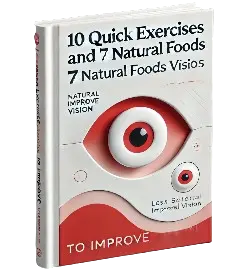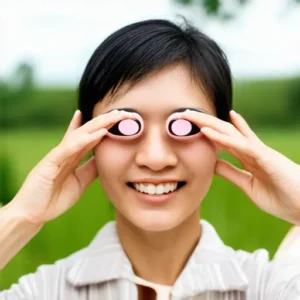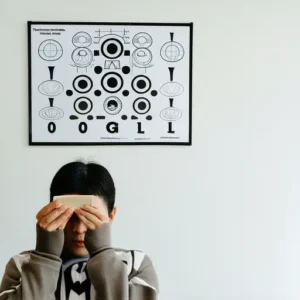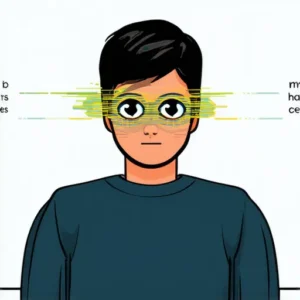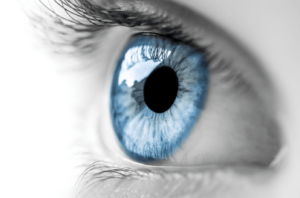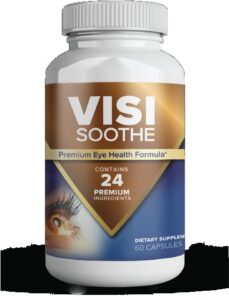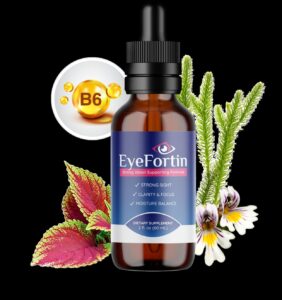5 Eye Exercises to Increase Your Eyesight in 30 Days
Can You Really Improve Your Eyesight Naturally? Let’s Find Out
Let’s face it—our eyes are working overtime these days. Between endless Zoom calls, binge-watching, and doomscrolling, it’s no wonder so many of us are dealing with tired, strained vision. But here’s the good news: you might be able to boost your eyesight naturally without reaching for stronger glasses or considering surgery. While serious conditions need professional care, simple eye exercises can work wonders for reducing fatigue, sharpening focus, and keeping your peepers in top shape.
How Your Eyes Actually Work (It’s Pretty Cool)
Your eyes are like tiny athletes—they’ve got muscles that constantly adjust to focus near and far. But just like skipping leg day at the gym, if we don’t give these muscles proper attention, they can get lazy. Throw in bad habits like squinting at screens in the dark, and no wonder our vision suffers. The exciting part? With the right exercises, you can train your eyes just like any other part of your body.
What Science Says About Eye Exercises
Research from the Journal of Behavioral Optometry shows that regular eye exercises can make a real difference. In their study, participants who stuck with a routine for 30 days reported less eye strain and better focus. Now, don’t expect miracles—these won’t reverse serious nearsightedness or astigmatism—but they’re like a daily vitamin for your vision.
Why 30 Days? The Magic of Consistency
Thirty days isn’t just a random number—it’s the sweet spot for forming habits and seeing real changes. Think about it: you wouldn’t expect six-pack abs after one workout, right? Your eye muscles need that same regular TLC.
Why Bother With Eye Exercises? The Perks You’ll Love
Before we jump into the how-to, let’s talk about why these exercises are worth your time.
Bye-Bye, Eye Strain
Digital eye strain is the modern plague—dry eyes, headaches, that awful gritty feeling. Simple tricks like palming and conscious blinking can hit the reset button on overworked eyes.
Sharper Focus (Literally)
Ever notice how your vision gets “stuck” after hours on your laptop? Exercises like focus shifting help your eyes snap between near and far objects like a camera lens.
Better Blood Flow = Brighter Vision
Your eyes thrive on good circulation. Movements like figure 8 tracing are like a mini workout that delivers oxygen and nutrients where they’re needed most.
5 Simple Exercises to Transform Your Vision in 30 Days
Ready to give your eyes the attention they deserve? Here’s your daily playbook:
1. Palming: Your Eyes’ Favorite Spa Treatment
This is like a warm hug for tired eyes—perfect after a long screen session.
- Rub your hands together until they’re nice and toasty
- Gently cup your palms over closed eyes (no pressure!)
- Breathe deep and enjoy the darkness for 2-3 minutes
2. The Focus Shifter: Train Your Eyes Like a Pro
Great for when your vision feels “sticky” after computer work.
- Hold a pen at arm’s length and stare at the tip
- Slowly bring it toward your nose until it’s about 6 inches away
- Reverse the motion. Repeat 10 times (go slow—no rush!)
3. Figure 8 Tracing: Your Eyes’ Dance Routine
This one’s oddly satisfying once you get the hang of it.
- Picture a giant sideways 8 (∞) about 10 feet away
- Trace it slowly with just your eyes—head stays still!
- After a minute, switch directions. Total time: 2 minutes
4. Blink Boost: The Simplest Trick You’re Not Doing Enough
We blink way less when staring at screens—time to fix that.
- Set a timer for 20 seconds and blink rapidly (like you’ve got something in your eye)
- Close your eyes and relax for 30 seconds
- Repeat 5 times throughout your day
5. The Zoom Effect: Flex Those Focusing Muscles
Perfect for when your eyes feel “stuck” at one distance.
- Stick your thumb out like you’re hitchhiking
- Focus on it as you slowly bring it toward your face
- Stop when it’s about 3 inches away, then extend back out. 10 reps!
Getting the Most From Your Eye Workouts
A few pro tips to maximize results:
Palming Like a Pro
Make sure no light sneaks in—it should feel like you’re in a cozy cave. Bonus points if you pair this with some deep breathing.
Focus Shifting Without the Dizziness
If things get blurry, pause and blink. This isn’t a race—slow and steady wins the vision race.
Mastering the Figure 8
Your head should be as still as a statue. If your eyes protest, slow down the tracing speed.
Making Eye Exercises a Daily Habit
Here’s how to stick with it:
When to Exercise Your Eyes
Morning routines prep your eyes for the day. Evening sessions help undo screen damage. Or sneak them in during bathroom breaks!
The Perfect Eye Exercise Combo
Start with palming to relax, do your focus exercises while fresh, and finish with blinking to rehydrate.
Tracking Your Vision Wins
Jot down small victories—maybe text looks sharper, or you’re rubbing your eyes less. Progress isn’t always dramatic!
Bonus Tips for Happier, Healthier Eyes
Pair your exercises with these eye-friendly habits:
Eat for Your Eyes
Load up on vision superfoods: carrots (yes, your mom was right), leafy greens, fatty fish, and colorful berries.
Give Screens a Break
Try the 20-20-20 rule: Every 20 minutes, look at something 20 feet away for 20 seconds. Your eyes will thank you.
Lighting and Sleep Matter
Reading in dim light is like doing squats in quicksand—pointless and painful. And never underestimate the power of good sleep for eye recovery.
Pitfalls to Avoid on Your Vision Journey
Steer clear of these common mistakes:
Overdoing It
If your eyes are screaming “uncle!”, listen to them. Gentle effort beats forced strain every time.
Being Inconsistent
Random workouts won’t cut it. Set phone reminders if you need to—your future self will be grateful.
Ignoring Red Flags
Persistent pain or worsening vision? That’s your cue to see an eye doctor, not push through with exercises.
The Bottom Line
Improving your eyesight naturally is absolutely possible—with patience and regular practice. Commit to these simple exercises for 30 days, and you’ll likely notice less strain, sharper focus, and happier eyes. Remember, vision care is a marathon, not a sprint. Why not start today? Your eyes are worth it!
Quick Recap:
- Daily eye exercises = happier vision in 30 days
- Combine with smart screen habits and eye-friendly foods
- Celebrate small improvements along the way
Have you tried any of these exercises? We’d love to hear what works for you—drop your experiences in the comments!
Can You Increase Visual Acuity with Simple Exercises?
Can You Actually Improve Your Eyesight Naturally? Let’s Find Out
Ever wished you could sharpen your vision without reaching for glasses or scheduling surgery? Most of us assume worsening eyesight is inevitable, but what if you could fight back with simple daily habits? While serious conditions need professional care, growing research shows that eye exercises, smart nutrition, and lifestyle tweaks might help you see clearer. Intrigued? Let’s separate fact from fiction and explore practical ways to boost your visual clarity—no prescriptions required.
Visual Acuity 101: Why Sharp Vision Matters
Think of visual acuity as your eyes’ HD setting—it’s what lets you spot your friend waving across a crowded room or read tiny text on a menu. That “20/20” standard? It means you can see clearly at 20 feet what should normally be visible at that distance. When this slips, everything from reading road signs to recognizing expressions gets harder. But here’s the good news: unlike your phone’s battery life, your vision might not be doomed to permanent decline.
Why Your Eyesight Might Be Blurring
- Father Time’s influence: After 40, presbyopia (that annoying need for reading glasses) creeps in.
- Screen overload: Binge-watching and Zoom marathons can leave your eyes feeling like overworked cameras.
- Diet gaps: Skimping on vitamins A, C, and E is like sending your eyes to work without proper tools.
- Couch potato eyes: Yes, your eye muscles can get lazy too!
The Eye Exercise Debate: What Science Says
Before you toss your glasses, know this: eye workouts won’t fix astigmatism or serious nearsightedness. But think of them like yoga for your peepers—they may reduce strain, improve focus flexibility, and keep your visual system running smoother. Techniques like palming aren’t magic, but they’re like a mini spa day for tired eyes.
Why Eye Exercises Deserve a Spot in Your Routine
Your eye muscles work harder than a barista on Monday morning. Here’s how targeted exercises help:
Building Eye Muscle “Gym Strength”
Those tiny muscles controlling your focus can get flabby from too much screen-staring. Exercises like near-far shifting are like dumbbell curls for your eyes—they help maintain focus agility.
Boosting Your Eyes’ Blood Supply
Poor circulation equals tired, dry eyes. Simple tricks like warm compresses act like a caffeine shot for your ocular tissues, delivering fresh oxygen and nutrients.
Fighting Digital Eye Exhaustion
Ever get that “sandpaper eyes” feeling after hours on your laptop? The 20-20-20 rule is like giving your eyes micro-vacations throughout the day.
3 Simple Eye Exercises You Can Try Today
No gym membership required—just a few minutes daily:
The 20-20-20 Rule: Screen Time’s Antidote
Every 20 minutes, pick something 20 feet away and gaze at it for 20 seconds. It’s like hitting your eyes’ reset button.
Palming: Your Mini Eye Retreat
- Rub your hands together like you’re warming them on a winter day.
- Gently cup them over closed eyes (no pressure—think cozy cave, not wrestling match).
- Breathe deep and imagine sinking into darkness for 1-2 minutes.
The Pen Drill: Focus Bootcamp
Hold a pen at arm’s length, focus on the tip, then slowly bring it toward your nose until it doubles. Reverse the motion. Repeat 10 times. Pro tip: Don’t use a sharp pencil!
Eat Your Way to Better Vision
Your eyes literally are what you eat. Key nutrients to stock up on:
Vision’s Dream Team Nutrients
- Vitamin A: Your retina’s best friend (hello, sweet potatoes and carrots).
- Lutein & Zeaxanthin: Nature’s blue-light blockers (load up on spinach and kale).
- Omega-3s: The ultimate dry-eye remedy (salmon and chia seeds to the rescue).
Superfoods for Super Sight
Think colorful: berries bursting with antioxidants, nuts packed with vitamin E, and fatty fish swimming with omega-3s. Your eyes will thank you.
Don’t Forget to Hydrate
Dehydrated body = dry eyes. Aim for eight glasses daily to keep your tears flowing (the good kind, not the sad movie kind).
Small Habits, Big Vision Gains
Quick fixes that add up:
Set Up Your Screen Like a Pro
Position monitors at eye level, dim harsh overhead lights, and say no to glare. Your eyes shouldn’t feel like they’re starring in a detective interrogation scene.
Schedule Eye “Coffee Breaks”
Pair your actual coffee with five-minute eye breaks every hour. Walk around—your body and vision will both benefit.
Sleep: Your Eyes’ Overnight Repair Shift
During deep sleep, your eyes recharge like little batteries. Skimping on shut-eye? You’re basically sending them to work without their morning coffee.
Busting Common Vision Improvement Myths
Will Eye Exercises Replace My Glasses?
Nope—think of them as supplements, not substitutes. They’re teammates with your prescription, not replacements.
When Will I Notice Changes?
Some people spot improvements in weeks; others take months. Consistency beats intensity here.
Can You Overdo Eye Exercises?
Absolutely. Your eyes aren’t marathon runners—moderation prevents strain.
Tracking Your Vision Progress
DIY Eye Tests
Snellen charts aren’t just for the doctor’s office—print one or use an app to check your vision monthly.
When to Call the Eye Doc
Sudden vision changes, pain, or zero improvement after three months? Time for professional backup.
Keeping Expectations Real
Natural methods work best for mild issues. Serious conditions need medical care—no shame in that game.
Wrapping Up: Your Vision Action Plan
The Quick Recap
- Exercise those eyes daily (20-20-20, palming, pen drills).
- Feed your eyes like you love them (colorful foods and hydration).
- Work smarter with screens (lighting, breaks, sleep).
Final Wisdom: Slow and Steady Wins the Race
Improving vision naturally isn’t an overnight miracle—it’s more like training for a 5K than taking an elevator. Celebrate small wins, stay patient, and remember: your eyes work hard for you every day. Isn’t it time you returned the favor?
Increase Vision of Eye: Myths vs. Facts
Can You Really Improve Your Eyesight Naturally? Let’s Find Out
Your eyes are your window to the world—but what happens when that window gets a little foggy? Between screen fatigue, aging, and everyday strain, many of us wonder if it’s possible to boost vision naturally. The good news? While there’s no magic cure, science shows we can absolutely support our eye health through simple, everyday choices. Let’s cut through the noise and explore what really works.
Why Your Eyes Deserve Some TLC
Think about how much your eyes do for you—from reading this text to spotting your morning coffee mug. When vision suffers, everything from work productivity to enjoying hobbies takes a hit. While genetics play a role, here’s the empowering truth: your daily habits make a bigger difference than you might think. The right nutrition, smart screen habits, and proper care can help preserve—and sometimes even enhance—your vision.
Eye Health Myths That Need to Die
Ever heard that carrots give you night vision like a superhero? Or that rubbing castor oil on your eyelids can replace glasses? The internet’s full of questionable advice about improving eyesight. Before we dive into what actually helps, let’s bust some persistent myths that just won’t quit.
Natural Vision Improvement: Separating Fact from Fiction
We all want quick fixes, but when it comes to your eyes, it’s crucial to know what’s legit and what’s just wishful thinking.
Myth: Carrots Are the Ultimate Eye Food
Yes, carrots contain beta-carotene (which your body converts to vitamin A), but no, eating a bushel won’t give you 20/20 vision. They’re part of the puzzle—not the whole picture.
Fact: Your Eyes Crave a Rainbow Diet
Leafy greens like spinach protect against blue light damage, fatty fish keep eyes lubricated, and citrus fruits provide vision-protecting vitamin C. It’s about variety, not just one “miracle” food.
Myth: Eye Exercises Can Replace Your Glasses
While eye yoga might feel refreshing, it won’t reshape your cornea or cure nearsightedness. Think of it like stretching for your eyes—helpful for comfort, not a cure.
Fact: They’re Great for Screen-Weary Eyes
The 20-20-20 rule (every 20 minutes, look 20 feet away for 20 seconds) is a game-changer for digital eye strain. It’s like giving your eyes mini-vacations throughout the day.
Eat Your Way to Better Eye Health
Your grocery list might be the simplest vision booster you’re not using enough. Here’s what to stock up on:
Greens That Do More Than Popeye Knew
Kale and spinach contain lutein and zeaxanthin—nature’s sunglasses that filter harmful light. Pro tip: Add olive oil to help absorb these nutrients better.
Fish for Happy, Hydrated Eyes
Salmon’s omega-3s help prevent dry eyes—a must if you’re glued to screens. Not a fish fan? Flaxseeds and walnuts are great plant-based options.
Colorful Produce for Night Vision
Sweet potatoes, red peppers, and eggs (yes, the yolks!) provide nutrients that help your eyes adjust to darkness. Perfect for night drivers.
Simple Eye Exercises Anyone Can Do
While these won’t replace your prescription, they can make daily vision more comfortable:
The Digital Age Savior: 20-20-20 Rule
Set a phone reminder—this tiny habit prevents that end-of-day eye exhaustion we all know too well.
Near-Far Focus Game
Alternate between reading text on your phone and focusing on something across the room. It’s like a workout for your focusing muscles.
The Ultimate Eye Relaxation Technique
Warm your palms by rubbing them together, then gently cup them over closed eyes (no pressure!). Breathe deeply for 30 seconds. Instant calm for strained eyes.
Lifestyle Tweaks for Healthier Vision
Small changes that make a big difference:
Lighting Matters More Than You Think
Avoid glare by positioning screens at eye level and using warm, ambient lighting. Your eyes will thank you.
Smoking and Eyesight Don’t Mix
Beyond lung health, smoking doubles your risk of cataracts and macular degeneration. One more great reason to quit.
Hydration = Happy Eyes
Dry eyes? Up your water intake and consider a humidifier. Your eyes need moisture just like your skin does.
When to Call in the Professionals
Natural methods are great, but sometimes you need expert help:
Glasses Aren’t Failure
If squinting is your new normal, a proper prescription can be life-changing. Today’s lenses are thinner and more stylish than ever.
Considering LASIK?
For eligible candidates, this quick procedure can correct vision dramatically. Consultation is key—not everyone’s a good fit.
Don’t Skip Your Eye Exam
Many serious eye conditions show no early symptoms. Annual check-ups catch problems before they become irreversible.
The Truth About Eye Health Supplements
Walk down any pharmacy aisle and you’ll see bold claims. Here’s what’s worth your money:
Lutein Supplements: Helpful or Hype?
Research shows benefits for macular degeneration, but food sources are always better absorbed. Think supplements as backup, not replacement.
Bilberry’s Dubious Superpowers
While it might help circulation, don’t expect night vision goggles effects. Save your cash for proven options.
Red Flags in the Supplement Aisle
“Restores perfect vision in 7 days!” Yeah, no. Always check with your eye doctor before trying new supplements.
The Bottom Line on Natural Vision Care
While there’s no instant fix, consistent care adds up. Think of it like retirement savings for your eyes—the small deposits you make today pay off later.
Quick Recap of What Actually Works
- Eat the rainbow (especially leafy greens and colorful veggies)
- Give your eyes screen breaks (20-20-20 is gold)
- Get professional check-ups (prevention beats cure)
Your Turn
What’s your go-to trick for tired eyes? Found a particular food that helps your vision? Drop your experiences in the comments—let’s learn from each other!
Increase Vision: Best Eye Exercises to Try Today
Can Eye Exercises Really Improve Your Vision? Here’s What Works
Let’s face it—most of us are glued to screens these days, and our eyes are paying the price. Blurry vision, eye strain, and that tired, gritty feeling have become all too common. But what if simple eye exercises could help sharpen your vision naturally? While glasses and contacts correct vision, exercising your eye muscles can boost focus, reduce fatigue, and might even help you see more clearly over time.
Whether you’re nearsighted, farsighted, or just battling screen fatigue, adding a few quick eye workouts to your routine could make a real difference. Let’s dive into the science-backed techniques that can help bring your world into clearer focus.
How Eye Exercises Actually Work
Your eyes have muscles—six to be exact—and just like your biceps, they need regular workouts to stay strong. When we stare at screens all day, these muscles get stuck in “near vision” mode, becoming stiff and weak. Targeted exercises can improve their flexibility, coordination, and focusing power. Research shows they may help with:
- Digital eye strain (you know that post-screen headache?)
- Mild nearsightedness
- Age-related focusing issues
Why Your Vision Might Be Getting Worse
Blame these common culprits:
- Screen addiction: Hours scrolling = eye muscles stuck in “zoom mode”
- Getting older: Your eye’s lens loses flexibility (thanks, time)
- Diet gaps: Missing key vision nutrients like lutein and omega-3s
- Family history: Thanks, Mom and Dad
The Truth About Eye Exercises
Let’s clear up some myths:
Myth: “Eye workouts can replace your glasses.”
Reality: They’re more like physical therapy for your eyes—great for maintenance but not a cure-all.
Myth: “Glasses make your vision weaker.”
Reality: That’s like saying crutches make your legs weaker. Nope.
Pro tip: If you suddenly can’t see the big E on the eye chart, skip the exercises and call your eye doc ASAP.
Simple Eye Exercises Anyone Can Do
Ready to give your peepers a workout? Try these easy moves:
Palming: The Ultimate Eye Spa Treatment
Try this:
- Rub your hands together until they’re warm (like you’re prepping for a magic trick)
- Gently cup them over closed eyes—no pressure
- Breathe deep and imagine pure darkness for 1-2 minutes
Why it works: Resets strained eyes like a mini meditation session
The 20-20-20 Rule (Your Eyes’ Best Friend)
Every 20 minutes, look at something 20 feet away for 20 seconds. It’s like hitting the refresh button for your focus.
Pen Pushups for Sharper Focus
How to:
- Hold a pen at arm’s length (bonus points if it’s your favorite one)
- Slowly bring it toward your nose, keeping it clear
- When it doubles, pause and push it back out
- Repeat like you’re training for eye muscle Olympics
Next-Level Eye Training
For those ready to upgrade their eye game:
Near-Far Tag
Alternate focusing on your thumb and something distant (like a tree or clock). Hold each for 5 seconds—it’s like CrossFit for your focus.
Figure 8 Eye Dances
Trace an imaginary infinity sign (∞) with your eyes. Go slow—this isn’t a race.
Support Your Eye Health Off the Mat
Exercises work better with these lifestyle boosts:
Eat Like Your Eyes Depend On It (Because They Do)
- Leafy greens (think Popeye-level spinach)
- Fatty fish (salmon = eye candy)
- Bright orange veggies (carrots aren’t just for rabbits)
Screen Time Smarts
Try blue light filters, and for heaven’s sake, stop scrolling in bed. Your eyes need rest too.
How Often Should You Exercise Your Eyes?
Think of it like brushing teeth—regular short sessions beat marathon workouts:
- 5-10 minutes daily
- 20-20-20 breaks during screen marathons
The Bottom Line
While eye exercises won’t give you eagle vision overnight, they can reduce strain and keep your eyes working better, longer. Start with palming today—your tired screen eyes will thank you.
Your turn: Which exercise will you try first? Tell us in the comments!
How to Increase Peripheral Vision for Better Driving Safety
Widen Your View: How to Boost Peripheral Vision for Safer Driving
When you’re behind the wheel, tunnel vision just won’t cut it. That ability to catch movement out of the corner of your eye—your peripheral vision—is what helps you spot that cyclist swerving into your lane or the kid chasing a ball into the street. The good news? You’re not stuck with what nature gave you. With some simple exercises, smart habits, and lifestyle tweaks, you can actually train yourself to see more. Let’s explore how to sharpen those all-important side vision skills for safer, more confident driving.
Why Your Side Vision Matters More Than You Think
Think of your peripheral vision as your car’s early warning radar. While you’re focused on the road ahead, your side vision is working overtime to detect potential dangers. It’s what lets you:
- Spot that car merging without signaling
- Catch pedestrians stepping off the curb before they enter your path
- Notice traffic lights changing in your periphery
The Hidden Dangers of Limited Side Vision
When your peripheral vision isn’t up to par, you might notice:
- More “where did they come from?” moments with other vehicles
- Constantly turning your head to check blind spots
- Eye strain after driving, especially at night
- Trouble tracking moving objects to your sides
Research shows drivers with better peripheral vision react faster to hazards—sometimes making the difference between a close call and an accident.
Train Your Eyes Like a Pro
Just like any other skill, you can improve your peripheral vision with practice. Try these simple exercises:
5-Minute Eye Workouts
- Thumb Challenge: Hold your thumbs out to the sides at arm’s length. Slowly move them back until they disappear, then bring them forward just until you can see them again. Hold for 10 seconds—this trains your eyes to pick up edge objects.
- Color Catch: Have a friend wave colored objects (bright gloves work great) just outside your central vision while you stare straight ahead. Try to identify colors without looking directly.
- Window Focus: Put a small sticker on your window. Focus on it while gradually becoming aware of objects in the distance through your side vision.
Give Your Eyes a Break
Staring at screens all day? Your eyes need rest too. Every 20 minutes, look at something 20 feet away for 20 seconds. This simple trick helps prevent that tunnel vision effect.
On-the-Road Strategies
Combine your eye training with these driving habits:
Mirror Magic
Most of us set our mirrors wrong. Adjust them so you just see the side of your car when leaning slightly. This eliminates blind spots better than you’d think.
Smart Scanning
Make it a habit to:
- Check mirrors every 5-8 seconds
- Do quick head checks at intersections (windshield pillars can hide a lot)
- Use your side vision first when changing lanes—if you’re turning your head completely, your mirrors need adjusting
Tech That Helps (But Doesn’t Replace Good Habits)
While nothing beats natural awareness, these tools can help:
- Blind spot monitors: Great for alerts, but don’t rely on them completely
- Wide-angle mirrors: Helpful additions, though they can distort distances
- Specialty glasses: Can help with medical conditions, but won’t expand normal vision beyond its limits
Myths Busted
Let’s clear up some common misconceptions:
- “You can’t improve peripheral vision”: While your physical range is set, you can train your brain to notice more within that range
- “Only athletes need it”: Drivers process more visual information than most athletes—it’s crucial for everyone
- “It inevitably declines with age”: Some loss happens, but exercises and good habits can keep you sharp
Keep Your Eyes in Top Shape
Don’t forget the basics:
- Eat eye-friendly foods: Load up on leafy greens, fatty fish, and nuts
- Stay hydrated: Dry eyes mean blurrier vision
- Get enough sleep: Tired eyes are slow eyes
- Regular checkups: Many eye conditions start with peripheral vision loss
The Bottom Line
Improving your peripheral vision isn’t about superhuman abilities—it’s about making the most of what you have. Small, consistent efforts can lead to big improvements in your driving awareness. Why not start today with a simple mirror adjustment or the thumb exercise?
Have you tried any vision exercises? We’d love to hear what worked for you—share your tips below!
Tech Habits That Lead to an Increase in Eye Power
Your Screen Time Might Actually Be Good for Your Eyes—Here’s How
Let’s face it—we’re all glued to our screens these days. Whether it’s for work, doomscrolling, or binge-watching the latest series, our eyes are working overtime. While we often hear about the dangers of too much screen time, what if I told you some tech habits could actually boost your vision? Yep, you read that right! With a few smart tweaks, you can turn screen time into eye gym time.
In this guide, we’ll explore how everything from blinking exercises to screen distance can help strengthen your peepers. Whether you’re a digital nomad, hardcore gamer, or just someone who can’t put their phone down, these tips will help keep your vision sharp.
Why Your Eyes Deserve More Attention
Our eyes weren’t built for 12-hour Netflix marathons. All that screen staring can lead to dry eyes, blurry vision, and that awful “screen headache” feeling. But here’s the good news: just like any muscle, your eyes can get stronger with the right kind of workout.
The Surprising Link Between Screens and Stronger Vision
Here’s a plot twist—controlled screen time might actually help your eyes. When done right, focusing on different distances can give your eye muscles a healthy challenge. Think of it like weightlifting for your vision (minus the sweat).
Blue Light: The Unexpected Vision Booster
Blue light gets a bad reputation, but it’s not all bad news. In the right doses, it can actually help regulate your sleep cycle and even sharpen your vision.
How Blue Light Trains Your Eyes
Studies show that moderate blue light exposure can improve your ability to spot fine details. But like chocolate or coffee, the key is moderation—too much, especially before bed, can mess with your sleep and leave your eyes feeling fried.
Smart Ways to Handle Blue Light
- Night mode is your friend: Flip that switch when the sun goes down.
- Break it up: Try the 20-20-20 rule (we’ll get to that soon).
- Brightness matters: Match your screen to your room’s lighting to avoid that annoying glare.
Tech That’s Got Your Back
Apps like f.lux or Twilight automatically adjust your screen’s color temperature. And if you’re really screen-heavy, blue light glasses might be worth a try—many people swear by them for late-night work sessions.
The Magic of Screen Distance
Did you know holding your phone too close is like skipping leg day at the gym? It makes your eye muscles lazy. Here’s how to find the sweet spot.
The Goldilocks Zone for Screens
For computers: 20-30 inches away. For phones: at least 16 inches (about the length of your forearm). This gives your eyes enough room to focus without straining.
Turn Screen Time Into Eye Training
Try this trick: occasionally move your monitor slightly farther away. It’s like adding more weight to your workout—your eyes have to work a little harder, which builds strength over time.
Common Vision Mistakes We All Make
- The squint: That crinkled-forehead look? It’s a one-way ticket to Headache City.
- Screen cuddling: Holding devices too close trains your eyes to be lazy.
- Slouch life: Bad posture means less blood flow to your eyes—sit up!
Blinking: The Secret Eye Workout You’re Not Doing
Blinking is like breathing—we do it without thinking. But doing it on purpose? That’s where the magic happens.
Why Blinking Is a Big Deal
Every blink is like a mini windshield wiper for your eyes, spreading moisture evenly. Normally we blink 15-20 times a minute, but screens cut that in half—no wonder our eyes feel like sandpaper!
Easy Blinking Exercises
- The slow blink: Close gently, pause for 2 seconds, open wide. Repeat 10x.
- The butterfly: Rapid blinks for 20 seconds to refresh your eyes.
- The warm-up: Rub your hands together and cup them over closed eyes for 30 seconds (hello, mini spa break).
How Often Should You Do This?
Every 20 minutes of screen time. These micro-breaks can save your eyes from turning into the Sahara Desert.
The 20-20-20 Rule: Your Eyes’ Best Friend
This simple trick is like a reset button for your eyes—and it takes less time than checking your notifications.
What’s the Deal With 20-20-20?
Every 20 minutes, look at something 20 feet away for 20 seconds. It’s like giving your eyes a mini vacation.
How to Make It Stick
- Set a reminder (there are apps for this, like EyeCare 20 20 20).
- When it pings, find something distant to focus on (that tree outside works great).
- Actually take the break—no cheating!
Why Your Future Self Will Thank You
Stick with this habit and you’ll:
- Say goodbye to that 3pm eye fatigue
- Switch focus between near and far like a champ
- Potentially slow down vision changes
Gadgets That Actually Help Your Eyes
Not all screens are created equal. Some are basically eye-friendly cheat codes.
Monitors That Won’t Murder Your Eyes
- E-Ink: Like reading real paper (Kindle users know what’s up).
- High refresh rates: Smoother motion = less strain.
- Matte finishes: Bye-bye, annoying reflections.
Blue Light Glasses: Help or Hype?
The science isn’t totally settled, but many people report less strain—especially night owls burning the midnight oil.
Set Up Your Space for Happy Eyes
- Position your monitor just below eye level
- Get a chair that doesn’t turn you into a human pretzel
- Soft, indirect lighting is your BFF
Eat Your Way to Better Vision
What you put in your body affects what you see with your eyes—who knew?
Vision Superfoods
- Vitamin A: Carrots, sweet potatoes, spinach (your mom was right).
- Omega-3s: Salmon, flaxseeds—great for keeping eyes moist.
- Lutein & Zeaxanthin: Kale, eggs—nature’s blue light blockers.
Don’t Forget to Drink Up
Dehydrated? So are your eyes. Aim for 8-10 glasses daily, and consider a humidifier if your air’s drier than a stand-up comedian’s wit.
Bonus Eye Foods
- Bilberries: Night vision boost (perfect for late-night gamers).
- Almonds: Vitamin E protects your eye cells.
- Green tea: Antioxidants that help with eye strain.
Wrapping It Up
Who knew your screen habits could actually strengthen your vision? By managing blue light, practicing the 20-20-20 rule, and keeping the right distance, you’re giving your eyes the workout they need. Remember, great vision comes from smart screen use, eye exercises, and feeding your body the right stuff.
The TL;DR:
- Balance screen time with smart breaks to build eye strength
- Use blue light tools and ergonomic setups to reduce strain
- Hydrate and eat vision-friendly foods for the long game
Ready to show your eyes some love? Try these tips today and drop a comment below to tell us what works for you—we’re all in this screen-filled world together!
The Best Foods to Improve Eyesight for Old Age
Introduction: Eating Your Way to Better Vision as You Age
Let’s face it—our eyes aren’t what they used to be as we get older. But here’s some good news: what’s on your plate can actually help slow down vision decline. Think of food as your eye’s natural defense system. By loading up on the right nutrients, you can keep your peepers sharper for longer and reduce risks of common age-related eye problems. Let’s dive into how you can eat your way to better vision in your golden years.
Why Our Eyes Change With Age (And What You Can Do About It)
Remember when you could read the fine print without squinting? As we age, our eye lenses lose flexibility (hello, reading glasses!), and our retinas get thinner. Conditions like glaucoma and macular degeneration become more common. While you can’t stop the clock, the right foods can help you stay ahead of the game.
Your Plate: The First Line of Defense for Your Eyes
Food isn’t just fuel—it’s medicine for your eyes. Certain nutrients act like tiny bodyguards, protecting your vision from damage. The best part? You probably already have these vision heroes in your kitchen.
The Vision VIPs: Nutrients Your Eyes Crave
- Antioxidants (Vitamins C & E) – Your eye’s personal cleanup crew against cellular damage
- Vitamin A & Beta-Carotene – Night vision’s best friend and dry eye’s worst enemy
- Omega-3 Fatty Acids – Like a soothing balm for irritated eyes
- Zinc & Lutein – Your natural sunglasses from the inside
Antioxidant Powerhouses for Ageless Eyes
Free radicals are like bullies for your eye cells—but antioxidants are the superheroes that keep them in check. Here’s where to find them:
Berry Good Vision
Blueberries, strawberries, and blackberries aren’t just delicious—they’re like little vision bombs packed with protective compounds. Toss them in your morning oatmeal or yogurt for an easy eye boost.
Go Green for Your Peepers
Spinach and kale might not make you strong like Popeye overnight, but their lutein and zeaxanthin content does work wonders for filtering harmful light. Pro tip: sauté them with garlic for a flavor boost that’ll make you forget you’re eating healthy.
Nutty for Eye Health
A handful of almonds or walnuts makes the perfect crunchy snack that doubles as eye armor. Keep some in your purse or glove compartment for when hunger (and the need for better vision) strikes.
Vitamin A: The Original Vision Vitamin
This isn’t just any vitamin—it’s the OG when it comes to eye health. Without enough of it, night driving becomes even more challenging than it already is with age.
Carrots: Not Just for Rabbits
Remember when your mom said carrots would help you see in the dark? She wasn’t wrong. These crunchy orange sticks are packed with beta-carotene that your body converts to vision-protecting vitamin A.
Sweet Potatoes: Nature’s Eye Candy
Move over, carrots—sweet potatoes actually pack more vision-boosting power per bite. Roast them, mash them, or turn them into fries (baked, please) for a tasty eye health boost.
Red Bell Peppers: The Underrated Vision Hero
These colorful veggies are like a two-for-one deal for your eyes—loaded with both beta-carotene and vitamin C. Add them to stir-fries or slice them up for crunchy snacks.
Omega-3s: The Eye’s Best Friend
These healthy fats do more than just support your heart—they’re like a spa treatment for your eyes.
Fatty Fish: Swim Your Way to Better Vision
Salmon, tuna, and mackerel aren’t just delicious—they’re packed with DHA, a type of omega-3 that keeps your retina happy. Aim for two servings a week—your eyes (and taste buds) will thank you.
Seeds of Vision: Flax and Chia
Not a fish fan? No problem. These tiny seeds pack a plant-based omega-3 punch. Sprinkle them on salads or blend them into smoothies for an easy eye health upgrade.
How Omega-3s Fight Macular Degeneration
Think of omega-3s as your retina’s personal firefighters—they help put out inflammation that can lead to vision loss. Regular intake might just keep you seeing clearly longer.
Zinc and Lutein: The Dynamic Duo for Aging Eyes
These two nutrients work together like a well-oiled machine to protect your vision.
Eggs: Nature’s Multivitamin for Eyes
That humble egg in your fridge? It’s a powerhouse of both lutein and zinc. Whether you like them scrambled, poached, or boiled, you’re doing your eyes a favor.
Beans: The Musical Fruit That’s Good for Your Eyes Too
Chickpeas, lentils, and black beans offer vegetarian-friendly zinc to support night vision. Bonus: they’re budget-friendly and versatile in countless recipes.
Lutein: Your Eyes’ Natural Sunglasses
This nutrient acts like built-in shades for your eyes, filtering harmful light. Load up on leafy greens and eggs to stock up your lutein reserves.
Water: The Overlooked Eye Essential
You might not think about hydration when it comes to vision, but dry, irritated eyes often start with not drinking enough.
Why Tears Matter More Than You Think
Proper hydration keeps your tear production in check—and tears do more than express emotion. They keep your eyes comfortable and clear of irritants.
Eat Your Water
Cucumbers, watermelon, and citrus fruits help hydrate from the inside out. They’re like nature’s eye drops in food form.
The Dehydration-Vision Connection
Ever noticed your vision gets blurry when you’re parched? That’s your eyes begging for water. Keep a bottle handy and sip throughout the day.
Food Foes: What to Avoid for Better Vision
Just as some foods help, others can secretly sabotage your eye health.
Processed Foods: Not Worth the Eye Strain
That bag of chips might taste good now, but the sugar and unhealthy fats can lead to inflammation that harms your vision long-term.
Coffee and Cocktails in Moderation
Your morning java and evening nightcap might dehydrate you, leaving your eyes dry and irritated. Balance them with plenty of water.
How Poor Eating Habits Age Your Eyes Faster
A diet heavy in processed foods is like fast-forwarding your eyes’ aging process. The good news? It’s never too late to change course.
Beyond Food: Complete Eye Care for Seniors
While diet is crucial, it’s only part of the vision protection puzzle.
Don’t Skip Your Eye Exams
Think of annual eye check-ups like oil changes for your car—they keep everything running smoothly and catch problems early.
Shade Your Eyes in Style
Those sunglasses aren’t just a fashion statement—they’re essential armor against UV damage. Look for 100% UV protection.
Give Your Eyes a Workout
Simple exercises like focusing on near and far objects can help maintain flexibility. Your eye muscles need toning too!
Conclusion: Clear Vision for Years to Come
Taking care of your eyes as you age doesn’t have to be complicated. With smart food choices, proper hydration, and simple lifestyle habits, you can keep seeing life’s beautiful details clearly. Why not start today? Your future self—looking at gorgeous sunsets with clear eyes—will thank you.
Quick Vision Tips:
- Snack on colorful fruits and veggies daily
- Include omega-3s from fish or seeds 2-3 times weekly
- Drink water like your eyes depend on it (because they do!)
- Protect your peepers from UV rays
Final Note: Great vision at any age starts with daily choices. Share these tips with friends and family—after all, good vision is something worth seeing together!
Is Surgery the Best Way to Improve Myopia?
Diving into Myopia: What You Need to Know
In today’s digital world, with our eyes glued to screens and less time spent outdoors, myopia—or nearsightedness—is becoming a bigger issue. Millions are affected globally, prompting many to look for ways to tackle it. But is surgery the go-to answer? Before considering surgical routes, let’s break down what myopia is, its causes, and how it affects everyday life.
Myopia Uncovered: Seeing Near, Blurring Far
Myopia, or nearsightedness, is when you can see things up close just fine, but far-off objects? Not so much. This happens because either the eyeball is too long or the cornea has too much curve, making light focus in front of the retina instead of right on it. Often, myopia shows up in childhood and can get worse as you grow older.
Why Does Myopia Happen?
Myopia can be blamed on both genetics and lifestyle. If mom or dad is nearsighted, chances are their kids might be too. Add in factors like lots of reading, screen time, and not enough outdoor fun, and you have a recipe for myopia.
Living with Myopia: Day-to-Day Challenges
Having myopia can throw a wrench in daily tasks. Think about struggling to read road signs while driving, or identifying faces from afar. Left uncorrected, it can lead to eyestrain, headaches, and might even impact your work or studies.
Classic Ways to Manage Myopia
Before diving into surgery, many folks opt for tried-and-true methods to handle myopia. These non-invasive routes have been around for ages.
Glasses: The Go-To Fix
Glasses are the easiest, safest way to correct myopia. They tweak how light enters your eyes, helping it focus right on the retina. Plus, they’re easy to use, won’t break the bank, and can be customized for your vision needs.
Contact Lenses: Weighing the Options
Contacts offer another fix, giving a wider field of vision than glasses and being less in-the-way during activities. Just remember, they need good hygiene to avoid infections, and some might find them uncomfortable for long stretches.
Small Changes, Big Differences
Adjusting your lifestyle can help manage myopia. Cutting back on screen time, taking breaks during up-close work, and enjoying the great outdoors can make a difference. Eye exercises might help too, though results can vary.
Considering Surgery for Myopia
For a more lasting solution, eye surgery is an option. But before jumping in, it’s crucial to understand each procedure’s ins and outs.
LASIK: Fast and Effective
LASIK (Laser-Assisted In Situ Keratomileusis) reshapes the cornea with a laser, helping light focus correctly on the retina. It’s a quick procedure, usually done in 30 minutes, with most seeing better within a day.
PRK vs. LASIK: Which is Right for You?
While LASIK is popular, PRK (Photorefractive Keratectomy) is another option. It removes the cornea’s outer layer before reshaping. PRK recovery takes longer but might suit those with thinner corneas or dry eyes better.
Weighing the Pros and Cons of Surgery
Both LASIK and PRK come with risks like dry eyes or glare, but the upside is less reliance on glasses or contacts and a better quality of life. Chatting with an experienced ophthalmologist can help you weigh these options.
New Tech: Fresh Approaches to Myopia
Thanks to tech advancements, new surgical options are emerging, offering hope for those wanting less invasive solutions.
Exploring the SMILE Procedure
SMILE (Small Incision Lenticule Extraction) makes a tiny cut in the cornea to remove a lenticule. It’s less invasive than LASIK and offers quicker recovery with fewer side effects.
Corneal Implants: A New Frontier
Corneal implants, small devices inserted into the cornea, can correct refractive errors. Although mainly used for presbyopia, they show promise for myopia too. Plus, they’re reversible, which is a bonus for many.
Looking Ahead: Future Myopia Innovations
Research keeps pushing the envelope in myopia treatment. Innovations like gene therapy and advanced contacts are on the horizon, aiming for long-term solutions.
No Surgery? No Problem!
Not keen on surgery? No worries, there are non-surgical avenues to explore.
Orthokeratology: Nighttime Magic
Orthokeratology uses special lenses worn overnight to temporarily reshape the cornea, giving you clear vision by day without glasses or contacts. Just remember, the effects aren’t permanent.
Atropine Drops: Slowing Down Myopia in Kids
Low-dose atropine eye drops can slow myopia progression in children. While not a cure, they’re a useful part of a holistic treatment plan.
Vision Therapy: Can Exercises Really Make a Difference?
Vision therapy involves exercises to improve eye coordination and focus. While results vary, some find relief in symptoms and better eye health.
Should You Consider Surgery for Myopia?
Deciding on surgery is a big step and should be made with careful thought about different factors.
Things to Think About Before Surgery
Consider your age, how stable your prescription is, and any current eye conditions. Surgery tends to work better for those with stable prescriptions and healthy eyes overall.
Get Expert Advice
A chat with an eye care professional can give you personalized advice on your surgery options. They’ll guide you based on your unique needs.
Health and Lifestyle: What Matters?
Your lifestyle and health, like diabetes or autoimmune issues, can affect your decision. It’s important to discuss these with your healthcare provider.
Real Stories: Living with Myopia Surgery
Hearing from those who’ve had myopia surgery can provide valuable insights into the experience.
Success Stories: Life After Surgery
Many people find their quality of life improves significantly post-surgery, enjoying activities like swimming or sports without glasses or contacts.
Facing Challenges and Getting Used to Changes
While there are many success stories, some folks face hurdles like dry eyes or night glare. Adjustment periods vary, so keep your expectations realistic.
Wrapping It Up
In the end, whether to improve myopia through surgery or other means is a personal choice that requires thorough research and professional guidance. Factors like how severe your myopia is, your lifestyle, and your health will guide you to the best decision. Whether you stick with traditional methods, opt for the latest tech, or consider surgery, there’s no shortage of options to help manage and improve myopia.
Be sure to have a chat with an eye care professional to explore the best treatment for you. Your vision is precious, so making an informed decision is key to a successful outcome.
Improve My Eyes with These Vision-Boosting Tips
Taking Care of Your Vision: Simple Steps to Healthier Eyes
Think of your eyes as the windows to your world. Keeping them healthy is key to enjoying life to the fullest. If you’ve ever asked yourself, “How can I make my eyes better?” you’ve come to the right spot. This guide is packed with practical tips to naturally boost your vision and keep it in top shape.
Often, we don’t think about our vision until something goes wrong. But by understanding the importance of eye health and making some lifestyle tweaks now, you can greatly enhance your quality of life. These changes won’t just improve your eyesight—they can also ward off common vision issues that tend to crop up as we get older.
Why Eye Health Matters
Your eye health is a big part of your overall well-being. Having healthy eyes means you can fully enjoy activities like reading, driving, or just soaking in the beautiful sights around you. Sadly, many people don’t pay attention to their eyes until they start having problems like blurry vision or eye strain.
Everyday Vision Problems and Their Effects
Issues like nearsightedness, farsightedness, and astigmatism can really throw a wrench in your daily life. They not only make seeing clearly a challenge but can also lead to headaches and fatigue. Luckily, making some lifestyle changes can provide a lot of relief.
How Lifestyle Tweaks Can Boost Your Vision
Small tweaks in your daily habits can have a big impact on your eye health. Everything from your diet to how you handle stress affects your vision. Let’s dive into some of these changes that can help you see better and keep your eyes healthy for the long haul.
Eat Right for Better Vision
Key Nutrients for Eye Health
Vitamins like A, C, E, and minerals like zinc are crucial for keeping your eyes in tip-top condition. They help fend off macular degeneration and cataracts, which are common as we age. Omega-3 fatty acids also play a big role in supporting the retina.
Foods That Naturally Enhance Vision
Adding nutrient-rich foods to your diet can naturally boost your eyesight. Try including carrots, spinach, and citrus fruits in your meals. Fatty fish like salmon and mackerel are fantastic sources of Omega-3s that benefit your eyes.
Supplements for Eye Health
While food is the best source of nutrients, supplements can help fill in the gaps. Look for ones with lutein and zeaxanthin, as they are known for their eye health benefits. Just remember to check in with a healthcare provider before starting any new supplements.
Exercise Your Eyes for Better Sight
Simple Eye Exercises to Strengthen Vision
Just like your body, your eyes benefit from regular exercise. Techniques like the 20-20-20 rule—looking at something 20 feet away for 20 seconds every 20 minutes—can help ease eye strain and sharpen focus.
How Regular Vision Training Helps
Vision training can improve how well your eyes work together. Exercises like shifting focus between nearby and distant objects can strengthen your eye muscles.
Preventing Eye Strain with Exercises
With so much time spent on screens, eye strain is common. Regular eye exercises can relax your eyes, boost blood flow, and reduce discomfort.
Healthy Habits for Happy Eyes
The Power of Staying Hydrated
Keeping hydrated is vital for eye health. Without enough water, your eyes can become dry and uncomfortable. Make sure you’re drinking enough fluids to keep your eyes moist.
How Sleep Affects Your Vision
Good sleep is crucial for your eyes. While you rest, your eyes get replenished with nutrients. Skimping on sleep can lead to eye strain and vision problems over time.
Cutting Down Screen Time
Too much screen time can lead to digital eye strain. Taking regular breaks and using screen filters can cut down on glare and help protect your eyes.
Protective Strategies for Eye Health
Why Sunglasses Are Essential
Sunglasses are more than a fashion accessory—they shield your eyes from harmful UV rays. Opt for sunglasses with 100% UV protection to keep your vision safe.
The Role of Regular Eye Check-Ups
Regular eye exams are key to catching vision issues early. Your eye doctor can provide tailored advice to improve your eyesight and tackle any specific concerns.
How Blue Light Glasses Help
The blue light from screens can mess with your sleep and cause eye strain. Blue light glasses can filter these rays, giving your eyes some much-needed relief.
Tech Solutions for Better Vision
Exploring Vision Correction Options
If you have serious vision problems, procedures like LASIK can make a world of difference. Talk to an eye specialist to find out what might work for you.
Using Contacts and Glasses
Corrective lenses can instantly improve vision issues. Whether you go for glasses or contacts, these tools are vital for keeping your vision in check.
New Tech in Eye Care
Innovations like smart glasses and advanced contact lenses offer exciting new ways to support and enhance your vision.
Lifestyle Tweaks for Better Eyesight
Managing Stress for Better Vision
Stress can take a toll on your vision. Techniques like meditation and yoga can help manage stress, benefiting both your mind and your eyes.
Creating an Eye-Friendly Workspace
Setting up your workspace with proper lighting and ergonomic furniture can reduce glare and eye strain, making your workday more comfortable.
Developing a Vision-Friendly Routine
Incorporate eye-friendly habits into your daily life, like taking regular screen breaks and doing eye exercises. Consistency is crucial to maintaining healthy eyes.
Wrapping Up
Essential Tips for Better Eye Health
Improving your eye health involves a blend of good nutrition, exercise, protection, and lifestyle choices. By following these tips, you can make a big difference in your vision and overall eye health.
Your Path to Better Vision
Improving your eyesight is a lifelong journey. As you adopt these strategies, you’re likely to see improvements in both your vision and quality of life. Don’t forget to seek personalized advice from healthcare professionals, and feel free to share your progress to inspire others on their journey to better eye health.
Improve Long Sightedness: Foods That Boost Eye Health
Kickstarting Better Vision: Can Diet Improve Long Sightedness?
Ever found yourself squinting at something up close, while things at a distance are perfectly clear? If so, you might be dealing with long sightedness, or hyperopia. Glasses and contacts are the usual go-tos, but did you know that what you eat can also make a big difference? By adding certain nutrient-rich foods to your meals, you might just give your eye health a natural boost.
In this piece, we’re diving into how a balanced diet can be your ally in better eye health. We’ll highlight the superstar foods that bring the most benefits, and touch on vitamins, minerals, and even lifestyle tweaks that can work hand in hand with your diet. Ready to see how nutrition can help with long sightedness? Let’s get going!
Getting to Know Long Sightedness: What Causes It and How It Feels
Long sightedness happens when your eyeball is shorter than usual or your cornea’s curve is too flat, making light focus behind the retina instead of directly on it. This can blur nearby objects, cause eye strain, headaches, and make reading a challenge. While genes are a big player here, aging and lifestyle choices can also have their say.
Why Nutrition Matters for Your Eyes
Your diet doesn’t just keep your body ticking—it’s crucial for your eyes too. Eating foods packed with vitamins, minerals, and antioxidants can support how your eyes work and might even slow down vision problems. Knowing which foods are eye-friendly can help you make smarter choices to potentially ease long sightedness.
Feast Your Eyes: Nutrient-Packed Foods to Help Long Sightedness
Leafy Greens: The Vision Powerhouse
Think spinach, kale, and collard greens. These leafy wonders are loaded with lutein and zeaxanthin, antioxidants that shield your eyes from harmful light and fend off chronic eye diseases. Making these greens a regular part of your diet can be a game-changer for tackling long sightedness.
Fatty Fish: Omega-3’s Best for Your Eyes
Fish like salmon, mackerel, and sardines are swimming in omega-3 fatty acids, great for keeping your retinas healthy and reducing inflammation. Omega-3s can help combat dry eyes and age-related macular degeneration, making them a must for anyone looking to improve their vision naturally.
Colorful Veggies: Eat the Rainbow for Sharp Eyes
Bringing a splash of color to your plate with veggies like carrots, sweet potatoes, and bell peppers provides a range of antioxidants and vitamins. These veggies are rich in beta-carotene, a precursor to vitamin A, which is crucial for good vision. A colorful diet means a balanced intake of nutrients to support your eyes.
Antioxidants: Your Eye’s Best Defense Against Long Sightedness
Vitamins C and E: Your Eye’s Shield
These vitamins are antioxidant powerhouses, protecting your eyes from the wear and tear of free radicals. Citrus fruits, strawberries, and bell peppers are packed with vitamin C, while nuts, seeds, and vegetable oils are great sources of vitamin E. Together, they help keep your eyes in tip-top shape.
Berries: Tiny Fruits with Big Benefits
Berries like blueberries, blackberries, and raspberries are brimming with anthocyanins, antioxidants that enhance vision and protect your eyes. Adding a handful of these to your daily routine is a delicious way to give your eyes a helping hand.
Essential Vitamins and Minerals for Better Sight
Vitamin A: The Guardian of Vision
Vitamin A is essential for keeping your vision sharp by supporting your retina and preventing night blindness. Carrots, sweet potatoes, and liver are top sources, making them key players in the fight against long sightedness.
Zinc: The Unsung Hero of Retinal Health
Zinc helps move vitamin A from your liver to your retina, where it creates melanin, a protective pigment. Foods like oysters, red meat, and poultry are rich in zinc, supporting your retinal health.
Lutein and Zeaxanthin: The Dynamic Duo
Found in high concentrations in the macula, lutein and zeaxanthin help filter out harmful blue light and protect your eyes. Foods like kale, spinach, and corn are rich in these carotenoids and can be a boon for your eye health.
Hydration: A Simple Boost for Your Vision
Hydrate for Healthier Eyes
Keeping your eyes hydrated is key to avoiding dry eyes and potential vision problems. Drinking plenty of water throughout the day helps keep your eyes comfortable and can aid in improving long sightedness.
Herbal Teas: A Relaxing Sip for Your Eye’s Comfort
Herbal teas like chamomile and green tea not only hydrate but also offer antioxidants that support eye health. Green tea is especially rich in catechins, which may protect your eyes from oxidative damage. Enjoying a daily cup can be a soothing addition to your eye care routine.
Lifestyle Tweaks to Enhance Your Diet Efforts
Eye Exercises: Workouts for Your Eyes
Add some simple eye exercises to your routine to strengthen those eye muscles and improve focus. Moves like focus change and figure eights can enhance flexibility and support your quest to improve long sightedness.
Protection First: Cutting Down Screen Time and UV Exposure
Reducing screen time and shielding your eyes from UV rays are crucial for eye health. Use blue light filters on your devices and sport sunglasses with UV protection to lessen strain and protect your eyes from potential harm.
Busting Myths and Uncovering Facts About Diet and Vision
Myth-Busting: Separating Fact from Fiction
There’s a lot of buzz about diet and eye health, like the idea that munching on carrots alone will fix your vision. While carrots are great, a well-rounded diet with a variety of nutrients is what truly supports eye health.
The Science Behind Dietary Changes
Research backs up the role of nutrition in eye health. Studies show that a diet rich in vitamins A, C, E, and omega-3 fatty acids can lower the risk of eye diseases and help with long sightedness.
Wrapping It Up
Key Takeaways
Boosting your diet with a variety of nutrient-packed foods, staying hydrated, and making smart lifestyle changes can all help protect and improve your vision. Leafy greens, fatty fish, and colorful veggies are top picks, while vitamins and antioxidants play a vital role in eye health.
Final Thoughts
Taking charge of your diet and lifestyle can support your vision and potentially improve long sightedness. Always consider chatting with a healthcare provider or nutritionist for tailored advice. If you found this guide helpful, why not share it with someone who might benefit from these tips?

